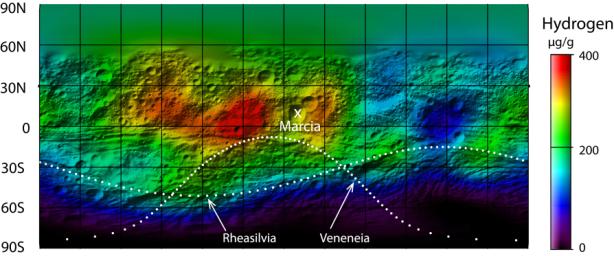This map from NASA's Dawn mission shows the global distribution of hydrogen on the surface of the giant asteroid Vesta. The hydrogen detected by Dawn's gamma ray and neutron detector instrument likely exists in the form of hydroxyl or water bound to minerals, not as water ice.
Scientists thought it might be possible for water ice to survive near the surface around the giant asteroid's poles. But the strongest signature for hydrogen came from regions near the equator, where water ice is not stable.
The abundance of hydrogen is displayed on a rainbow color scale. Red indicates the greatest abundances of hydrogen; violet indicates the least. The units are micrograms of hydrogen per gram of surface material. One set of dotted lines indicates the outline of the largest impact basin on Vesta known as Rheasilvia. The second largest impact basin, Veneneia, is outlined with the other dotted line. Marcia crater is indicated with an X.
The map is a cylindrical projection spanning 360 degrees of longitude. The hydrogen data, obtained in Dawn's lowest mapping orbit from December 2011 to May 2012, are superimposed on a shaded relief map of Vesta made from data from Dawn's framing camera. Dawn arrived at Vesta in July 2011 and departed in September 2012.
Dawn's mission to Vesta and Ceres is managed by JPL for NASA's Science Mission Directorate in Washington. JPL is a division of the California Institute of Technology in Pasadena. Dawn is a project of the directorate's Discovery Program, managed by NASA's Marshall Space Flight Center in Huntsville, Ala. UCLA is responsible for overall Dawn mission science. Orbital Sciences Corp. in Dulles, Va., designed and built the spacecraft. The gamma ray and neutron detector instrument was built by Los Alamos National Laboratory, N.M., and is operated by the Planetary Science Institute, Tucson, Ariz.
More information about Dawn is online at http://www.nasa.gov/dawn and http://dawn.jpl.nasa.gov.

 Planetary Data System
Planetary Data System












